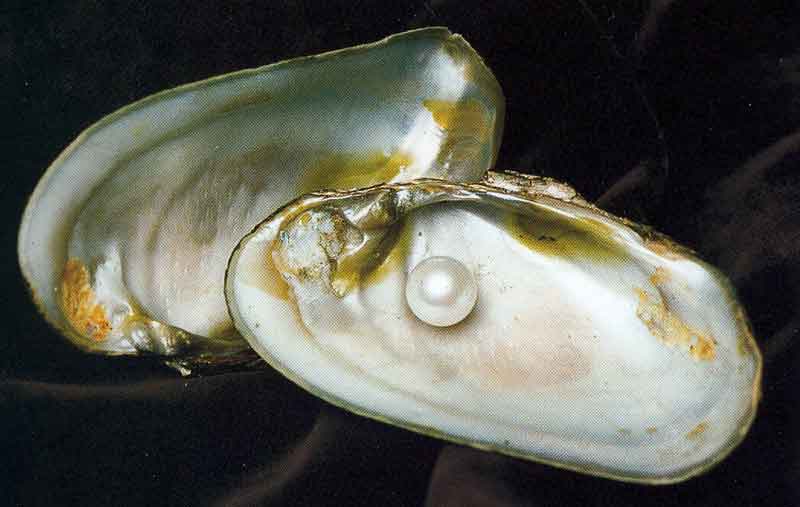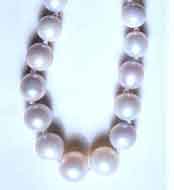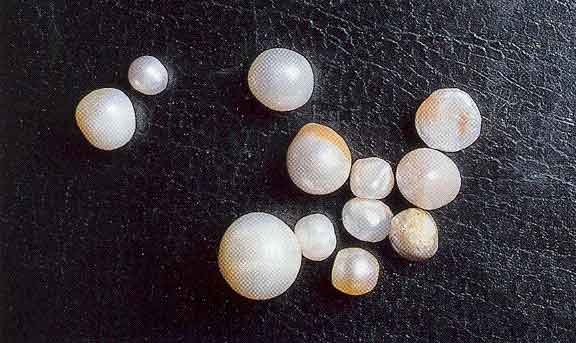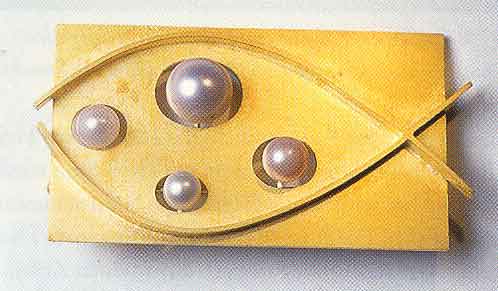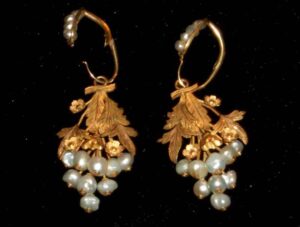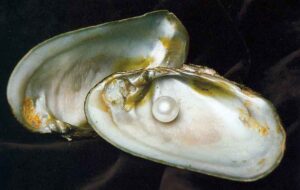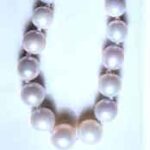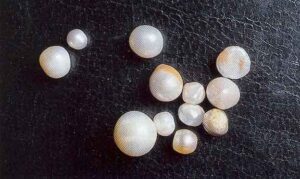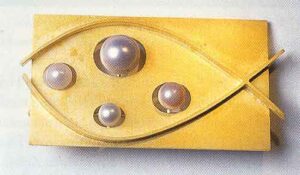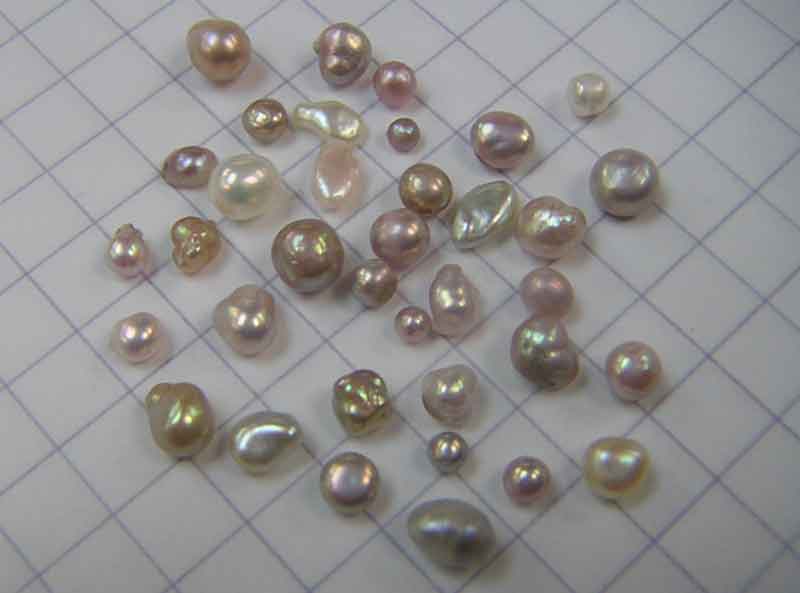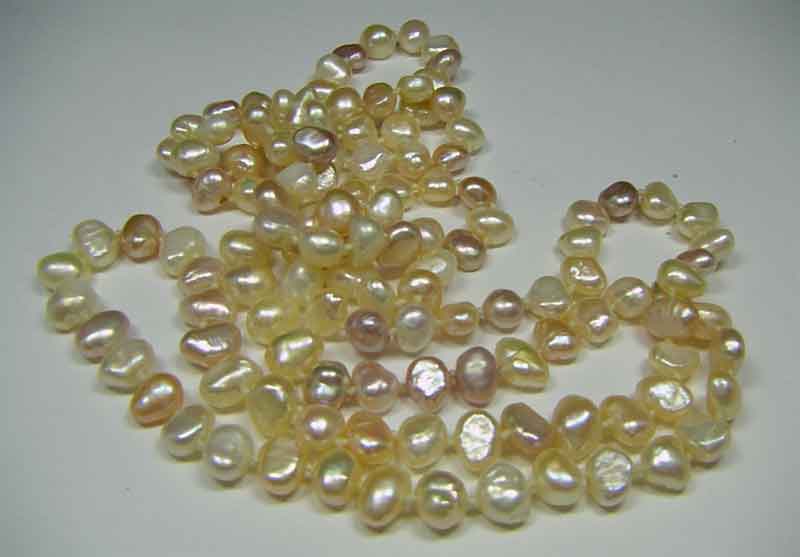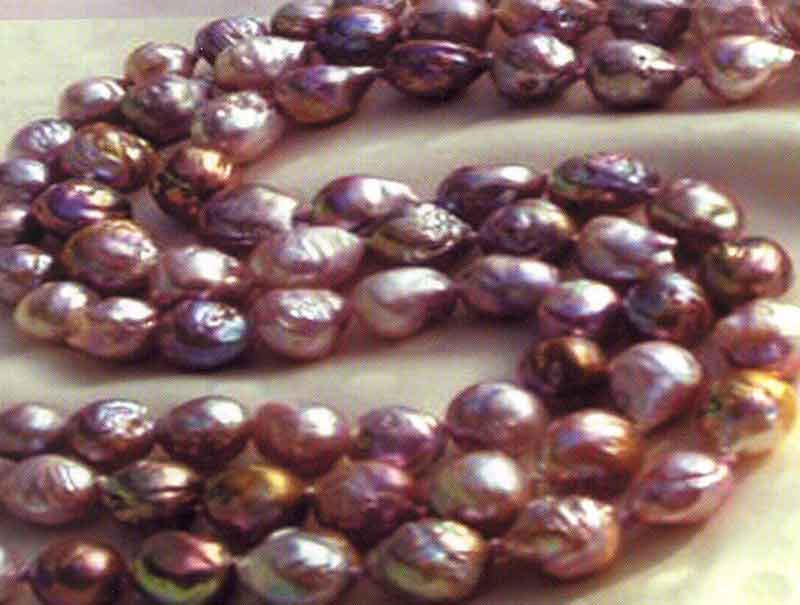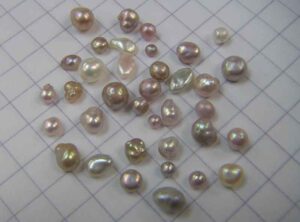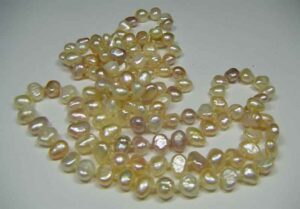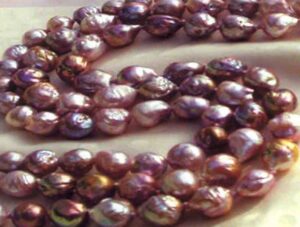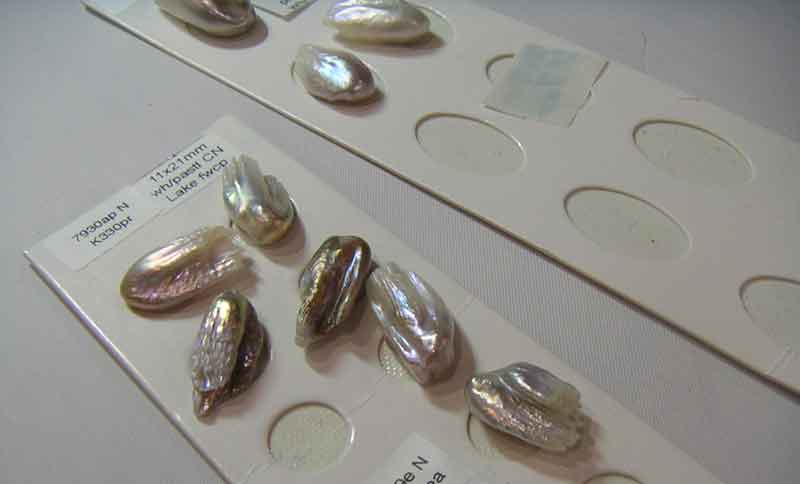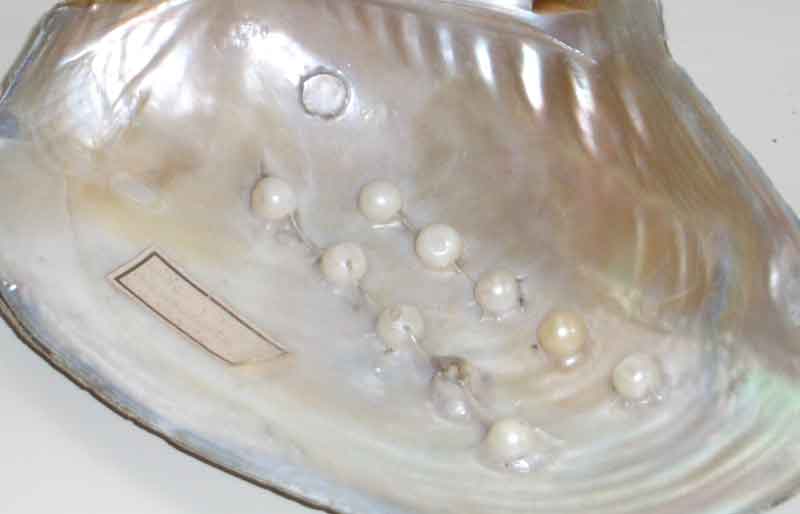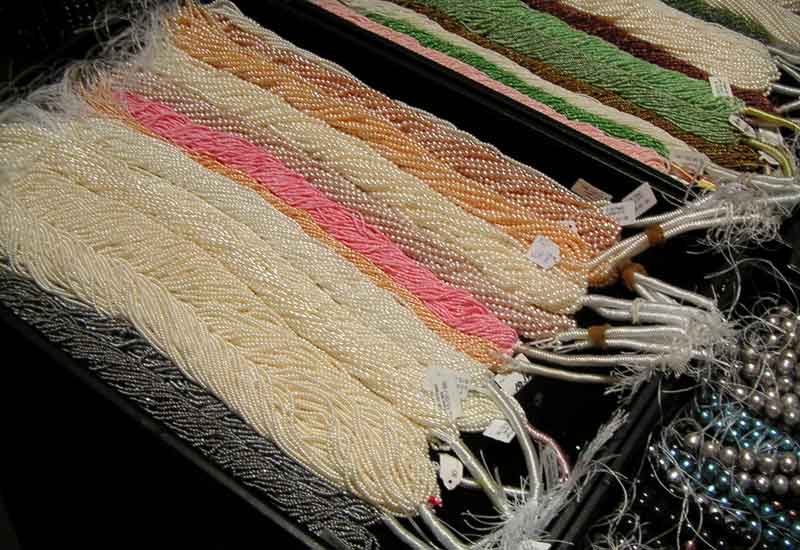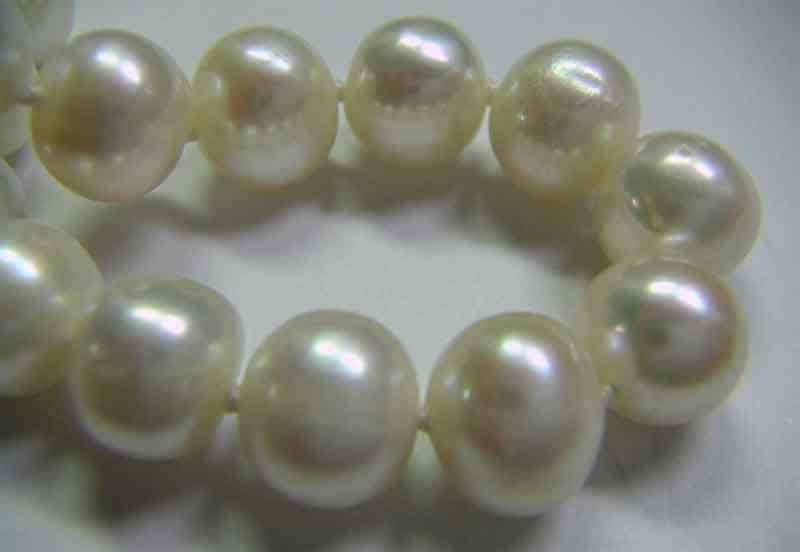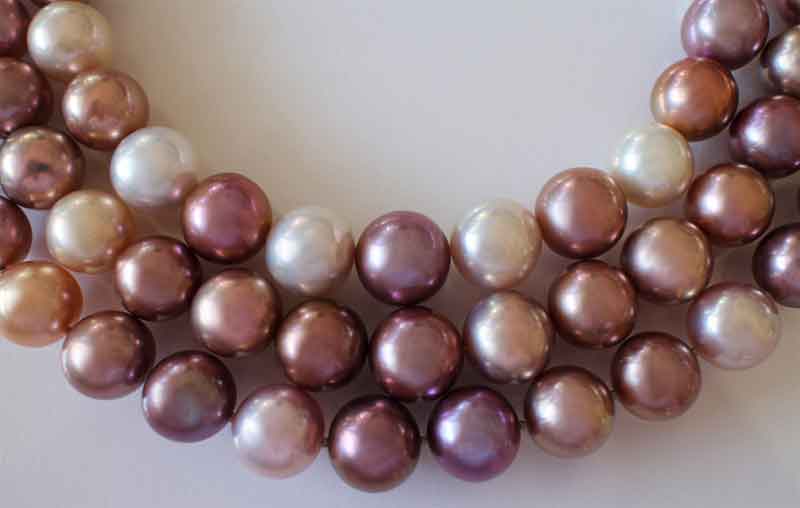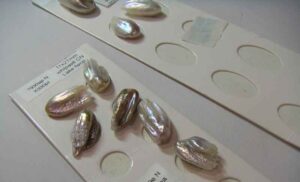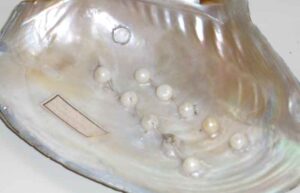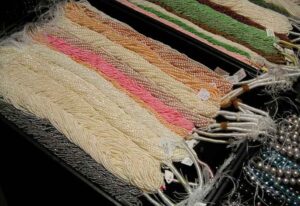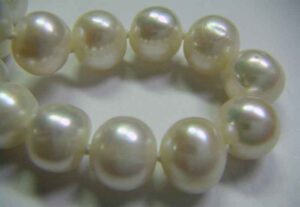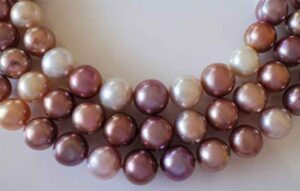By Elisabeth Strack
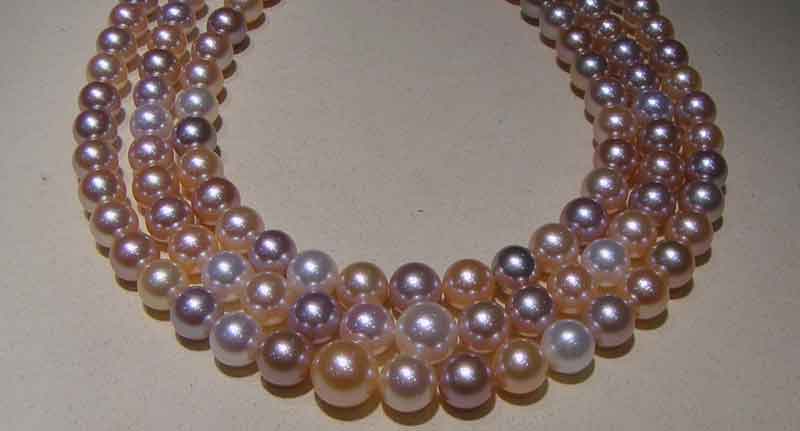
Photo courtesy Mastoloni
Pearl-producing freshwater mussels occur in a wide geographical distribution on the Northern Hemisphere, resulting in natural pearls in Europe, North America, and East Asia, and, today, supplying the vast quantities of cultured pearls in China.
All pearl-producing freshwater mussels belong to the superfamily Unionida, of which two families, Margaritiferidae and Unionidae, have been found to produce pearls regularly.
Europe
Regarding European pearl production, the only mussel of importance is Margaritifera margaritifera (Linnaeus, 1758). Also called the European pearl mussel, this species can reach lengths up to 160 mm and live as long as 300 years (Altmüller, 2009), representing the highest life expectancy of all known invertebrates. The species is so highly specialized that it requires either the common trout or the Atlantic salmon as a host fish, for it is in the gills of these fish where the mussels’ the young larvae, glochidia, pass the first half year of their lives. Today, Margaritifera is listed as “vulnerable,” and pearl fishing is prohibited.
Notable pearl specimens have been found in many European locales, from northern Spain to northwest Russia. In the latter, the Republic of Karelia and the Kola Peninsula are home to some of the largest pearl mussel populations, thanks to a healthy ecological environment where Atlantic salmon are the host fish. Historically, Russian freshwater pearls have been used in jewellery (Figure 1), as well as for decorating kokoshniks (Russian head dresses) and embroidering dresses.
In western Europe, pearls from Great Britain date back to the Romans, with documented mentions from Pliny the Elder, Tacitus, and Suetonius. From the Middle Ages onwards, Scottish pearls, collected from mountain streams, gained popularity on the European market, where they may have been sold as “oriental pearls.” While pearl fishing in Scotland once served as a rewarding trade, the practice has since been banned. Nonetheless, a memorable highlight of the era occurred in 1967 when Bill Abernethy, one of the country’s last professional pearl fishers, found a round, perfect pearl, measuring 11.5 mm, which was later named “Little Willie” (Figure 2).
Most Scottish pearls are on the smaller side. Only about one per cent of all mussels contained a pearl and only one in 100 pearls was of any value. Even so, these varieties are famous for their striking snow-white colour with a lilac hue (Figure 3). These days, Cairncross of Perth Jewellers has the largest collection of Scottish pearls and has been granted a licence from the Scottish government, enabling the sale of specimens sourced prior to the ban.
In central Europe, most freshwater pearls are of German origin, coming from an area stretching from the Saxonian Voigtland and the Bavarian Fichtel Mountains, bordering on the Czechian Egerland in the north, to the Bavarian Forest in the south (where pearls occurred in tributaries of the Danube River). Farming locales continue east into the Austrian Mühlviertel and the Czechian Moldau area.
In the late 19th century, the town of Adorf (located in Saxony) became a hub for working the shells of local pearl mussels into decorative objects and, today, a museum still gives witness to the once well-known Saxonian mother-of-pearl industry. The famous Grünes Gewölbe (Green Vault) in Dresden housed, among its treasures, a quite unique 18th century necklace with pearls from the Saxonian Elster River. Unfortunately, the historic piece was stolen from the museum during the notorious Dresden Green Vault heist in November 2019 and has not yet resurfaced. (Examples of Bavarian pearls can be seen in Figures 4.)
In North Germany, the pearl mussel occurs in the Lüneburg Heath area, south of Elbe River (less than 100 km from Hamburg), representing one of the few lowland occurrences. Pearls of fine quality here were rare. The brooch pictured in Figure 5 demonstrates so-called “Heath pearls,” which are perfectly round with a clean surface, and show a faint, purplish hue.
In the past 100 years, occurrences of pearl mussels in Europe have decreased significantly, with environmental protection measurements aimed at preserving the ecological equilibrium only introduced in the last 30 years (though these efforts are not directed at eventually harvesting pearls or at producing cultured pearls).
America
More than 300 species of freshwater mussels in the United States produce pearls—of these, 60 do so regularly. Distribution is mainly in waterways of the East coast and the Mississippi River, along with its tributaries in the Midwest. All mussels belong to the Unionidae family and distinguish themselves from Margaritifera insofar as they have a much shorter life span and are less demanding when it comes to the selection of a host fish. Generally speaking, they are more resistant.
More than 150 years ago, there was vast production of American pearls during the so-called “pearl rush.” This began in New Jersey, circa 1857, with the discovery of a 15-mm pink pearl by shoemaker David Howell and his friend, Jacob Quackenbush (the finding, ultimately, brought the two men a fortune, and it was eventually sold to the French Empress Eugenie de Montijo). From there, the pearl rush spread to Pennsylvania, New York, and the New England states, and, in the 1870s, to Ohio, Kentucky, Tennessee, and Alabama. In 1889, pearls were also discovered in Wisconsin.
Consequently, American pearls rose to fame on the world market, where they achieved prices comparable to the finest oriental pearls. The so-called Rothschild necklace, kept at the Boston Museum of Fine Arts, is a unique witness of the period. Dating from the first decade of the 20th century, the necklace was given by Meyer D. Rothschild to his wife, Edith. He personally selected the pearls from countless parcels, looking only for perfect ones (only one pearl in 10,000 would have been round), which closely matched in rosé colour.
The vast majority of American pearls are off-round to baroque in shape and occur in a plethora of colours—particularly pearls from Wisconsin, which distinguish themselves by a variety of pastel hues (Figure 6); however, individual high-quality white pearls have also been recovered in the United States.
Asia
East Asia is known worldwide for its incredible freshwater cultured pearls. Production started in Japan’s Lake Biwa in 1924, but it was not until the late 1960s that “Biwa pearls,” representing unbeaded cultured pearls in irregular shapes and colours other than white, became known on the world market. Popularity reached its height in the 1970s when the pearls were embraced as an element of hippie style (Figure 7).
Farms in Lake Biwa used the Hyriopsis schegelii mussel, which is endemic to Japan and locally referred to as “Ikecho-gai.” To ensure continuous production, mussels were transferred from Lake Biwa to Lake Kasumigaura as early as the 1930s; however, it was not until around 1993—around the same time production at Lake Biwa drew to an end—pearls from Lake Kasumigaura reached a high-quality level.
Today, yearly pearl production from Lake Kasumigaura is around 10 kg, representing a negligible quantity, albeit of high quality. Farmers solely apply the “in body” method, whereby a drilled mother-of-pearl bead is inserted with the help of a needle into the mussel’s gonad. The pearls distinguish themselves by intense purplish to pink and orangey hues and sizes of up to 15 mm (Figure 8). Perfectly round shapes are rare, yet high-quality necklaces can achieve prices of more than $100,000.
While it is certainly correct to assume natural pearls from the Ikecho-gai and other freshwater mussels were known in Japan for centuries, it is difficult to say if they ever played a role as objects of cultural or material value (comparable to the European river pearl), as there are virtually no records found outside of Japan.
China
Comparably little is published regarding natural freshwater pearls from China; however, considering the vast number of waterways in a country of such an enormous size, it is safe to assume there has been considerable yield. One wonders what has become of those pearls and if there was a market for them. It is quite possible round and white pearls were preferred, culturally, and that pearls of irregular shapes and colours from lakes and streams in the country were not appreciated (Figure 9).
While natural freshwater pearls from China are extremely rare, the country is the main producer of cultured freshwater pearl varieties. Regular production started in the Song Dynasty of the 11th century. Pearl culture centred in a few villages north of today’s Zhejiang province. Farmers used both the Cristaria plicata mussel and the common pond mussel, Andonta woodiana. Beads consisting of dried mud, along with other materials (such as wood, metal, or mother-of-pearl), were inserted with the help of a forked bamboo stick. These were placed in two to three rows underneath the mantle onto the nacreous inside of the shell, where the outer epithelium layer of the mantle would slowly cover them with a secretion of mother-of-pearl. The resulting “pearls” had to be cut out of the shell at harvesting time, which took place after about 10 months. (According to today’s standards, these would be referred to as “cultured blisters,” as they differ from true cultured pearls insofar as they do not grow inside of the inner soft body.)
It was only in the second half of the 20th century (mainly in the 1970s) that China gained publicity in the pearl world with its production of freshwater cultured pearls. At first, the pearls, following the example of Lake Biwa specimens, showed irregular shapes and colours (Figure 10). Like Biwa pearls, these varieties were produced without inserting a mother-of-pearl bead. Instead, tiny pieces of mantle epithelium from a donor mussel were inserted into incisions of both sides of a mussel’s mantle, where they multiplied by cell-division and joined into an epithelium or pearl sack.
Mass production soon followed. By the 1980s, Chinese pearls (often artificially dyed) were sold by the kilo and prices reached bottom level (Figure 11). In the early 1990s, farmers switched from Cristaria plicata to Hyriopsis cumingii, the local equivalent of the Japanese Ikecho-gai. Consequently, pearl quality improved and nearly round pearls appeared on the market, accompanied by a price hike (Figure 12). It did not take long, however, for cost to drop again, thanks to repeated mass production.
More recently, the early 2000s saw new techniques involving the use of mother-of-pearl beads, which enabled the production of large, colourful pearls of baroque shapes. These are marketed under several names, but are most commonly referred to as “Fireballs” (Figure 13).
All that lustres…
By and large, China remains the largest producer of freshwater cultured pearls worldwide, with a yearly production of around 1,000 tons. A variety of prices exist side by side, going from artificially dyed low qualities to quite decent roundish or baroque shapes of natural colours at affordable prices. Fine qualities are also available, in both beadless and with an implanted mother-of-pearl bead. The cost of necklaces depends on size, shape, colour, and general perfection. These range dramatically in price, ranging from a few dollars to more than $10,000.
Generally speaking, production has slightly gone down in the last few years, with a concentration shifting to better qualities, accompanied by slight to pronounced price increases. Since 2010, intensely coloured pearls in purplish hues (resembling those from Lake Kasumigaura) are being produced in China using the latest mother-of-pearl bead techniques. These specimens are internationally marketed as “Edison pearls.”
 Elisabeth Strack is a German gemmologist who has owned her own diamond, gem, and pearl testing laboratory in Hamburg since 1976. She is the author of the book Pearls, which was published in English in 2006. Strack can be reached via info@strack-gih.de.
Elisabeth Strack is a German gemmologist who has owned her own diamond, gem, and pearl testing laboratory in Hamburg since 1976. She is the author of the book Pearls, which was published in English in 2006. Strack can be reached via info@strack-gih.de.



